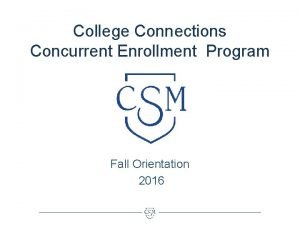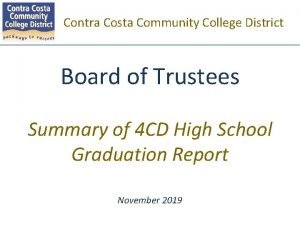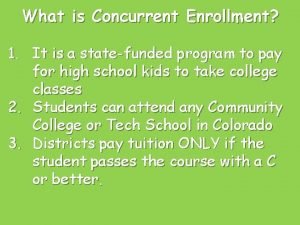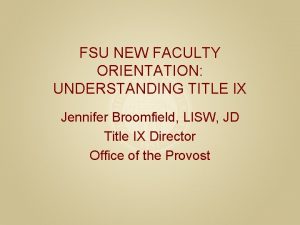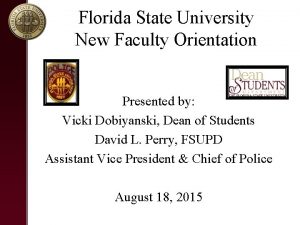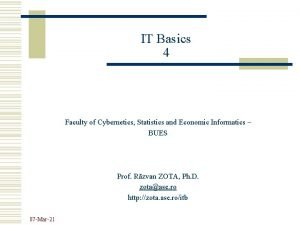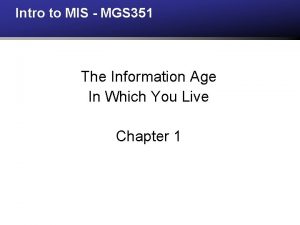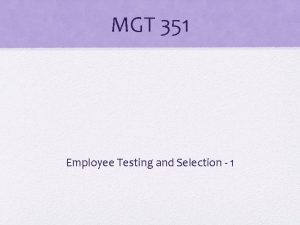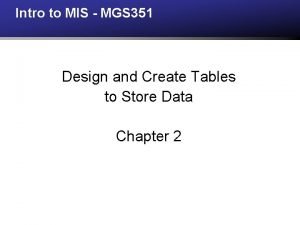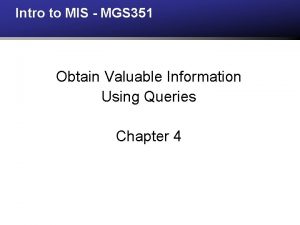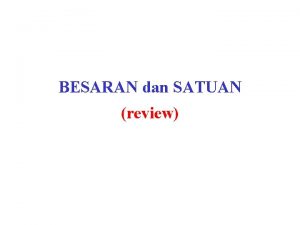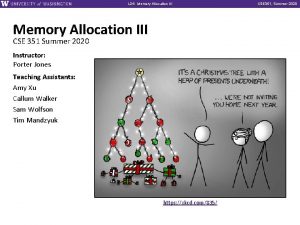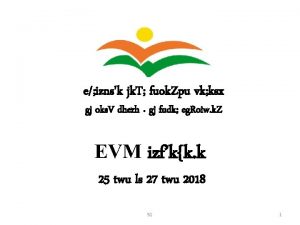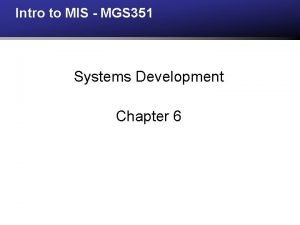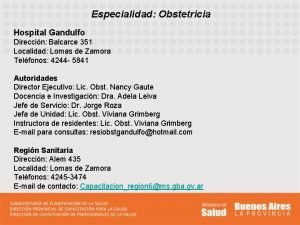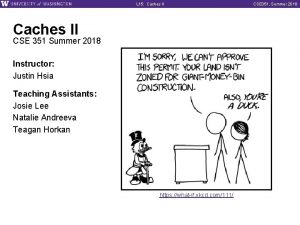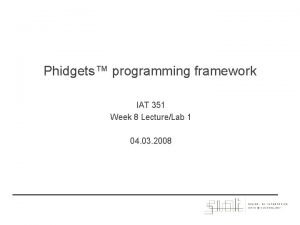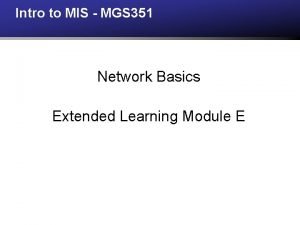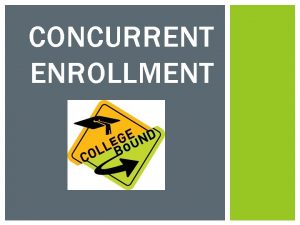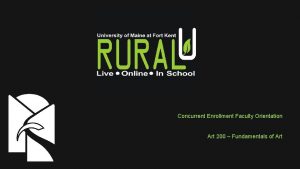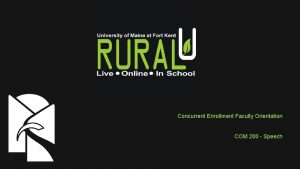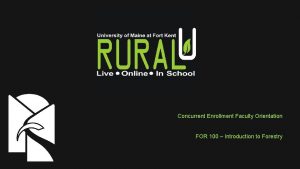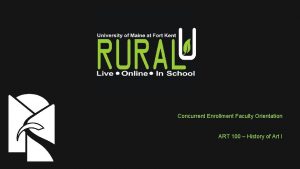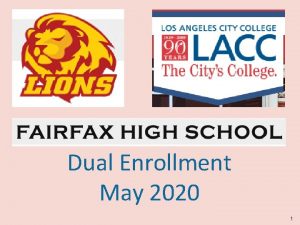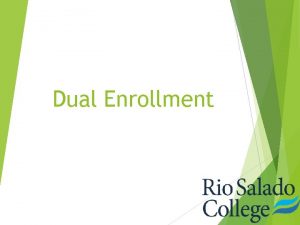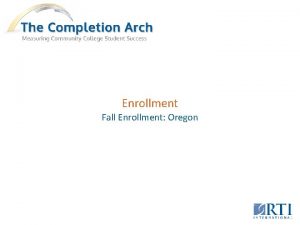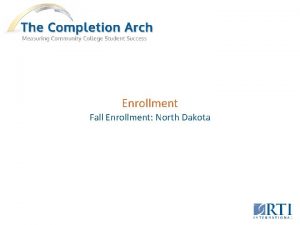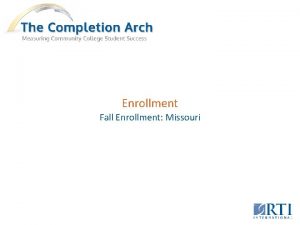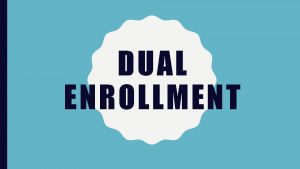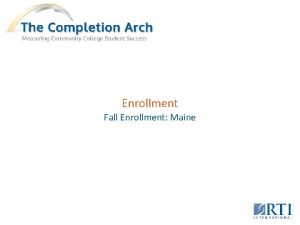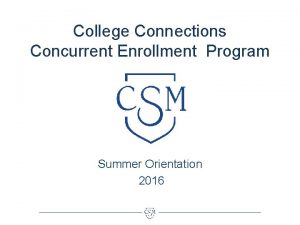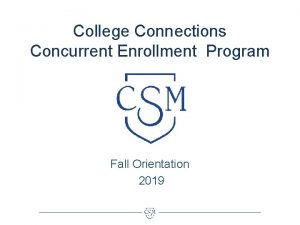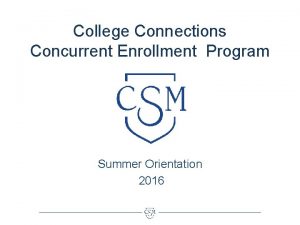Concurrent Enrollment Faculty Orientation MAT 351 Statistics I






















- Slides: 22

Concurrent Enrollment Faculty Orientation MAT 351 – Statistics I

Welcome, and thank you for embarking on this adventure! This module is designed to give you, the instructor the tools needed to help you prepare to instruct classes in your selected field at your high school. This module goes over all details you need to know about teaching your course, such as a course description, course philosophy and objectives, and expected learning outcomes. Click here to visit our website

Concurrent Enrollment Faculty Expectations Faculty across all sections will be expected to follow the established: 1. Syllabus learning outcomes 2. Instructional objectives 3. Common/similar course assessments 4. All other essential elements Click here to visit our website

Remember! When you teach a Rural U concurrent enrollment course, you are not just preparing students for college – you are teaching a UMFK college course. You may do more than what is in the syllabus, but you may not do less! Click here to visit our website

Orientation Agenda Course Curriculum Course Description Course Philosophy Required Texts/Materials for Instructors Student Learning Outcomes Student Evaluation Grade Scale Sample Tests/Quizzes/Writing Prompts Administrative Responsibilities National Alliance of Concurrent Enrollment Partnerships New Course Orientation Site Visits Annual Discipline Specific Meeting Grade Submission Course Evaluations References Complete Evaluation Slide(s) Slide 6 Slide 7 Slides 8 -9 Slide 10 Slides 11 -12 Slide 13 Slide 14 Slide 15 Slide 16 Slide 17 Slide 18 Slide 19 Slide 20 Slide 21 Slide 22

Course Description This course is designed for use in behavioral science, education, environmental studies, nursing, computer applications, natural science, and business. Introduces descriptive and inferential statistics with data handling emphasized. Topics includes measures of central tendency, distribution, normal distribution, t-distribution, hypothesis testing, correlation, linear regression, analysis of variance, chi-square and non-parametric analytical techniques. This course presents an integrated approach to Statistics by putting emphasis on developing conceptual and unified approach. We will start with careful consideration of Fundamental Concepts of descriptive statistics and study application of various inferential statistical tools. Click here to visit our website

Course Philosophy This is a modified flipped class. You will study course materials from each Chapter using blackboard course page before class and we will spend class time discussing problems and concepts you find difficult or confusing. I encourage your strong participation. You will need to raise questions and give feedback to questions posed by your peers and me. We all are learners. We will learn to think quantitatively, response logically and present systematically. Statistics and this syllabus might look intimidating, but we are here to learn, and I am here to help you. Never hesitate to ask question. Any question you have is an important one. We all are learners. We will learn to think quantitatively, respond logically and present systematically. This course might look intimidating, but we are here to learn, and I am here to help you. Never hesitate to ask me any question you might have. Any question you have is an important one. Continuous interaction between you and me regarding the course material will help UMFK’s mission to promote a quality education built upon a liberal arts foundation. Click here to visit our website

Required Texts/Materials for Instructors Elementary Statistics, A Step by Step Approach, 8 th or 9 th edition, by Bluman, Mc. Graw Hill. Statistics, The Art and Science of Learning from Data, 3 rd edition, by Agresti and Franklin, Pearson. Click here to visit our website

Required Texts/Materials for Instructors (continued) Supplemental Learning Resources: A calculator is required. You must also know how to use it, which means you will need to have the operating manual for it. We should use Microsoft Excel and R to solve some of Homework and Test Problems. Knowledge of statistical software such as Microsoft Excel, R, SAS, SPSS, or Matlab, will eliminate hours of repetitive labor and enable you to focus on the fundamental concepts of Statistics. There are instructions about the use of Excel at the end of each section in our textbook. We will discuss use of R in class. There is no reason to worry if you do not have Excel or do not know how to use. Almost every necessary computation for this course can be done using ordinary calculators. Several useful online calculators can be found using Google. Links to some of them are; http: //easycalculation. com/statistics. php http: //vassarstats. net/ https: //www. google. com/#q=online+calculator+ Click here to visit our website

Student Learning Outcomes Expected Learning Outcomes and Benefits: To complete this course successfully the student will demonstrate an ability to integrate the course content to meet following competencies. 1. Collect data by identifying variables necessary for a research. 2. Quantify data to solve problem of interest. 3. Describe and represent data by means tables and graphs. 4. Choose appropriate methods to accurately analyze data. 5. Compare various statistical tools in context of the problem. 6. Interpret and make decisions based on the data. 7. Evaluate and criticize analysis done by other scholars. 8. Explain statistical results logically and systematically. Click here to visit our website

Student Evaluation Projects: Several Projects will be assigned during the semester. Reasonable time will be given to work on the project. Projects should be done independently; no group work is allowed. Plagiarism will result into a course grade of “F”. Click here to visit our website

Student Evaluation (continued) Exams: There will be four midterm Exams and a Comprehensive Final exam. Your lowest exam grade will be dropped. However, you must score at least 60 % on the comprehensive final exam to pass this course. If you want to write a paper based on the material learned during this semester, the second lowest grade may be dropped based on your grade on the paper. You should start working on the paper from the beginning of this semester. You will need to find a problem or an issue that interest you and find associated data for quantitative analysis using tools discussed in this course. Please talk to me in advance (by the second week of the class) if you would like to choose drop the second lowest exam grade. You will have to come up with time table and plane to start the work on paper (at least the topic of interested and associated variables of interest should be identified by second week of the semester). Group work is not allowed for exams and projects and considered a plagiarism. Plagiarism will result into a course grade of “F”. Click here to visit our website

Grade Scale A A B+ B BC+ C CD+ D F 93 -100 90 -92 87 -89 83 -86 80 -82 77 -79 73 -76 70 -72 66 -69 60 -65 below 60 Click here to visit our website

Sample Tests/Quizzes/Writing Prompts MAT 351 Project 1 Sample* *Double-click on image to open example Click here to visit our website

National Alliance of Concurrent Enrollment Partnerships The University of Maine at Fort Kent’s Rural U program is working toward accreditation by the National Alliance of Concurrent Enrollment Partnerships (NACEP). NACEP works to ensure that college courses taught by high school teachers are as rigorous as courses offered on the sponsoring college campus. As the sole accrediting body for concurrent enrollment partnerships, NACEP helps these programs adhere to the highest standards so students experience a seamless transition to college and teachers benefit from meaningful, ongoing professional development. For more information, visit their website at: http: //www. nacep. org/

New Course Orientation Newly certified Rural U Concurrent Enrollment faculty are required to participate in the Rural U program orientation, which includes the course specific orientation, prior to teaching a new Rural U course. The purpose of this course orientation is to allow the faculty member to become familiar with the course prior to teaching. Rural U Concurrent Enrollment faculty will also have the opportunity to discuss the course with college faculty prior to teaching the course. Click here to visit our website

Site Visits 1. A faculty liaison from UMFK will conduct a site visit every 3 years. 2. During this visit, the faculty liaison may ask to see examples of exams, lab activities, and any other artifacts that will aid in determining if the course outcomes are being achieved. 3. An observation form will be shared with the Rural U Concurrent Enrollment faculty upon completion of the visit and may outline recommendations for improvements. 4. It is important to note, site visits are not an evaluation of you as a teacher. Site visits are conducted to determine if the course being taught is equivalent to the on-campus course. Click here to visit our website

Annual Discipline – Specific Meeting 1. Per NACEP standards – UMFK will host annual, discipline-specific professional development activities on campus and/or via distance technology. 2. These events are critical and required as they allow for open conversation between UMFK and Rural U Concurrent Enrollment faculty. 3. If UMFK identifies a pattern of absence over a two-year period, a Rural U administrator will discuss with the faculty member their continued participation in the program. Click here to visit our website

Grade Submission Rural U Concurrent Enrollment faculty must submit their final grades, in letter format, to Rural U program staff by February 1 (for fall classes) and June 30 (for spring classes). Classes that are a year-long must have grades submitted within the spring deadline. *In the event you are teaching a 4 -credit course with lab, please note you will need to enter two separate grades – one for the lecture part of the class and one for the lab part of the class. Click here to visit our website

Course Evaluations Rural U Concurrent Enrollment faculty must conduct end-of-term student university evaluations. These evaluations are comprised of questions focusing on the content of the course and are not an evaluation of your teaching methods. Results of the evaluation are available at your request, but these results do not have to be used in your personnel file. All evaluations will be provided to you by UMFK prior to the end of your class with instructions for completion. Click here to visit our website

References Rural U Homepage Click here to visit our website

New Course Orientation Survey To complete your New Course Orientation you will need to complete the brief survey found here https: //www. surveymonkey. com/r/88 HLK 8 F If you have been approved for more than one course, please review the other New Course Orientation presentations available before completing the survey. Should you have any questions or concerns please contact Rural U program staff. Click here to visit our website
 Websmart.smccd
Websmart.smccd Contra costa college concurrent enrollment
Contra costa college concurrent enrollment Define concurrent enrollment
Define concurrent enrollment Uco advisement
Uco advisement Greg naterer
Greg naterer Fsu new faculty orientation
Fsu new faculty orientation Fsu new employee orientation
Fsu new employee orientation Asc code
Asc code Ethnocentric vs polycentric vs geocentric
Ethnocentric vs polycentric vs geocentric Succeedsoft
Succeedsoft Mgt 351 nsu course outline
Mgt 351 nsu course outline Mgs 351
Mgs 351 Mgs351
Mgs351 43.351.097/0001-90
43.351.097/0001-90 Geology 351
Geology 351 Cse 351 lab5
Cse 351 lab5 +39 351 0787268
+39 351 0787268 Ceng 351
Ceng 351 Mgs 351
Mgs 351 Balcarce 351 lomas de zamora
Balcarce 351 lomas de zamora 351 cache simulator
351 cache simulator Iat 351
Iat 351 Mgs 351
Mgs 351
